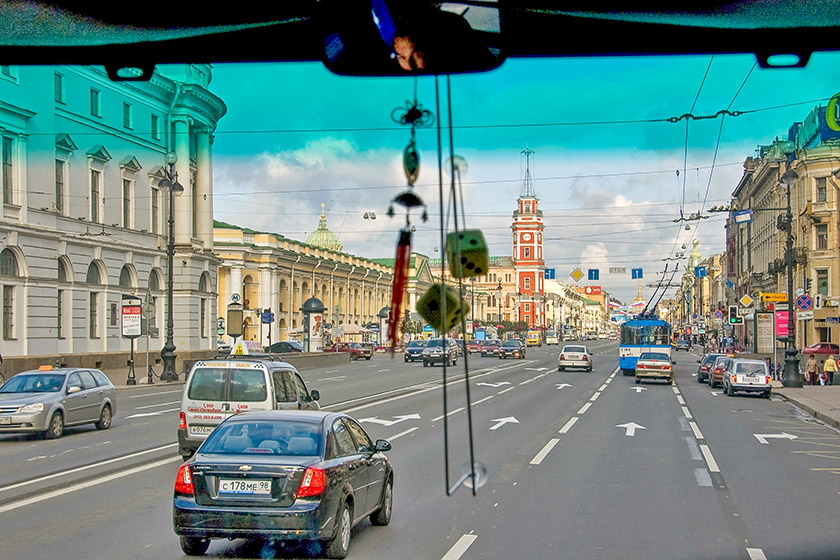
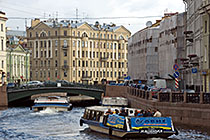
Driving down Nevsky Prospekt
Flat boats for low bridges
This is page 2 of our trip report. From here, you may go to Page 1
Click on any of the small images below to see a larger (2400x1600 pixel) version
There are many more photographs (but without accompanying text) in our Web Gallery.
This page was originally published in August of 2007 and completely redone in November of 2024. All photos were reprocessed from the original raw files, the thumbnail size was increased from 210x140 to 840x560 (displayed as 420x280), and the size of the large images was changed from 900x600 to 2400x1600. The text has remained essentially the same.
[July 28, 2007] Because of its extraordinary cultural and historic treasures, it is easy to forget that the city is, at least by European standards, rather young. Indeed, it was founded by Peter the Great in 1703. Our morning shore excursion featured a boat ride on the Neva as well as a visit to the Yusupov Palace (known, among other things, for the fact that Rasputin was assassinated in its basement in December of 1916). Our bus drove down Nevsky Prospekt (Nevsky Avenue), arguably the most famous street in all of Russia [55]. Because the water level of the canals and rivers was unusually high, we had to make a detour as we could not board our boat at the embankment normally used for that purpose. Most bridges are extremely low, and at times our boat had but an inch or two of clearance [56]. We passed Peter the Great's modest (in comparison to most other palaces: 'only' 14 rooms) summer palace where he lived from 1712 until his death in 1725 [57]. We were impressed by the width of the Neva river; the Trinity bridge was decorated with flags because the people were getting ready to celebrate Russian Navy Day on July 29 [58].
Our first afternoon stop was Saint Isaac's cathedral [59]. When it was completed in 1858, it was the largest church in Russia; today, it still is the third-largest domed cathedral in the world. In the center of Saint Isaac's Square is a monument honoring Nicholas I [60]; it was designed by the same architect who built Saint Isaac's (Auguste de Monferrand) and is notable for having only two support points, the horse's hind legs.

|

|
Driving down Nevsky Prospekt |
Flat boats for low bridges |
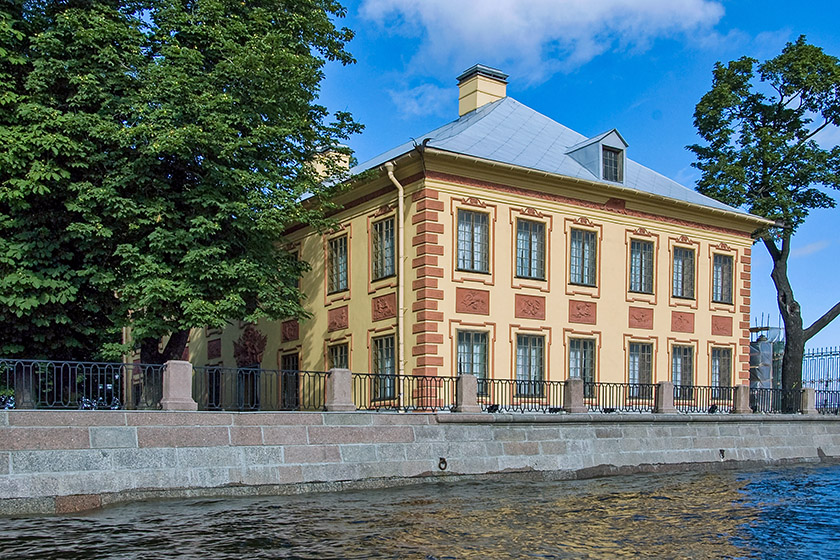
|
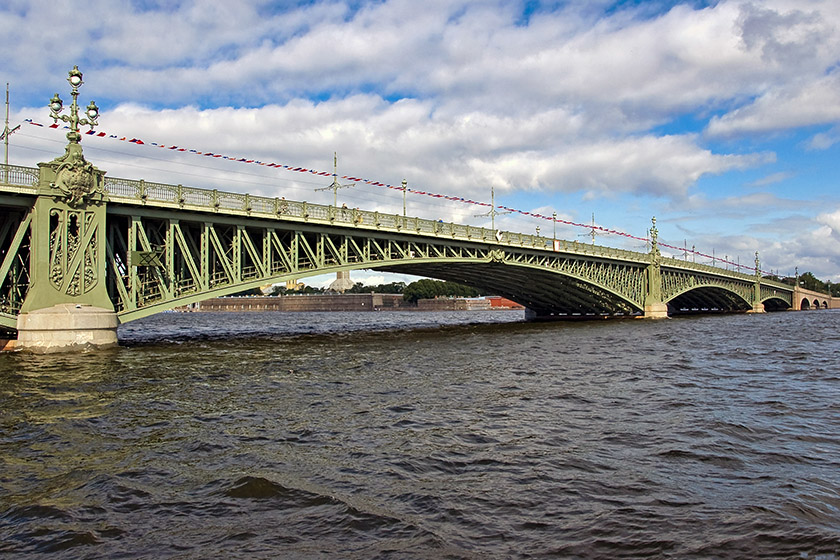
|
Peter the Great's Summer Palace |
> The Trinity Bridge |
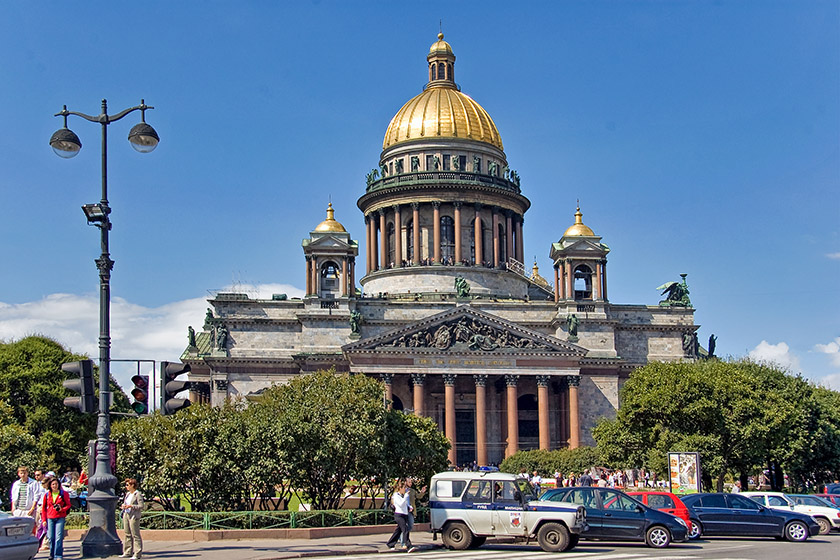
|
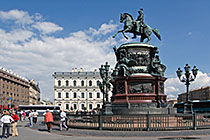
|
Saint Isaac's Cathedral |
Monument to Nicholas I |
Extending the line between the cathedral and the monument, we arrive at the opposite end of the square and Mariinsky Palace. Completed in 1844, it is now the seat of the Saint Petersburg Legislative Assembly [61]. The bus then took us to the north bank of the Neva; from there we had a very nice view of the Winter Palace (the Hermitage) before moving ahead to the Peter and Paul Fortress and Cathedral [62]. We were able to spend some time at the cathedral with its lovely cupola [63], beautiful nave [64], and colorful pulpit [65].On the way back, we passed the two rostral columns, one of which is shown here [66]. Originally, they served as light houses, and even today, the tops are lit by gas fire on special occasions. The columns were built of red granite in 1811 and are approximately 32 meters (106 feet) tall. They are adorned with bows of ships, or rostra, hence the name.
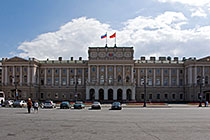
|
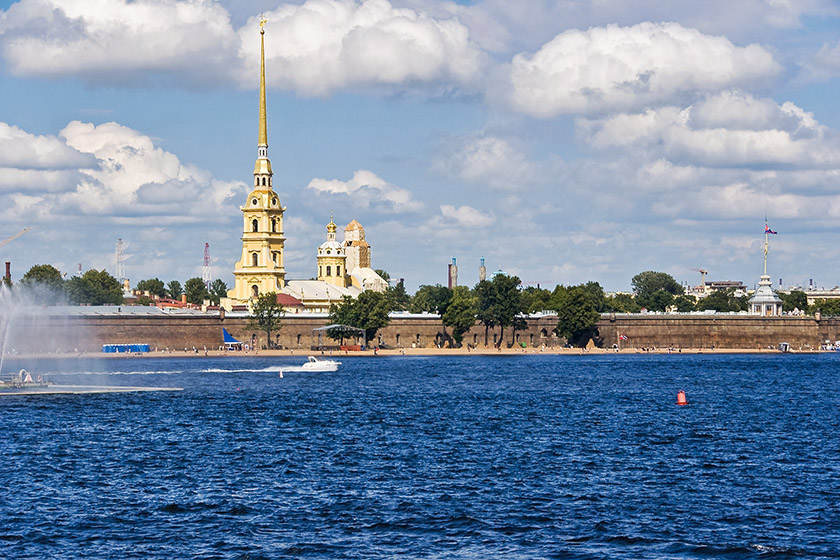
|
Mariinsky Palace |
Peter and Paul Fortress |
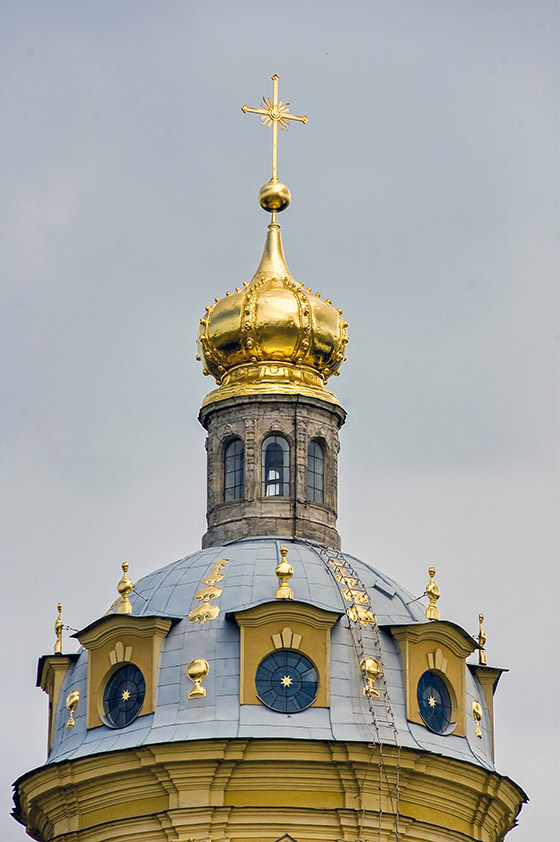
|
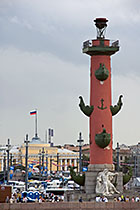
|
Cathedral cupola |
Inside the cathedral |
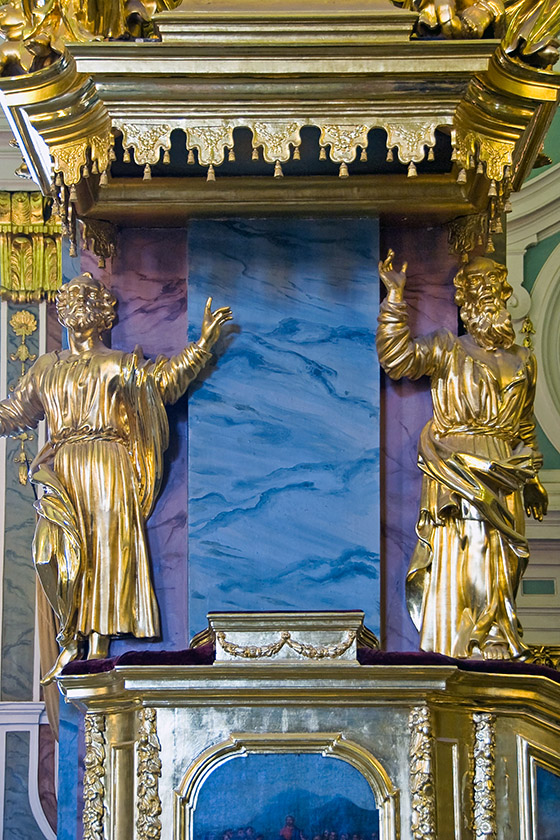
|
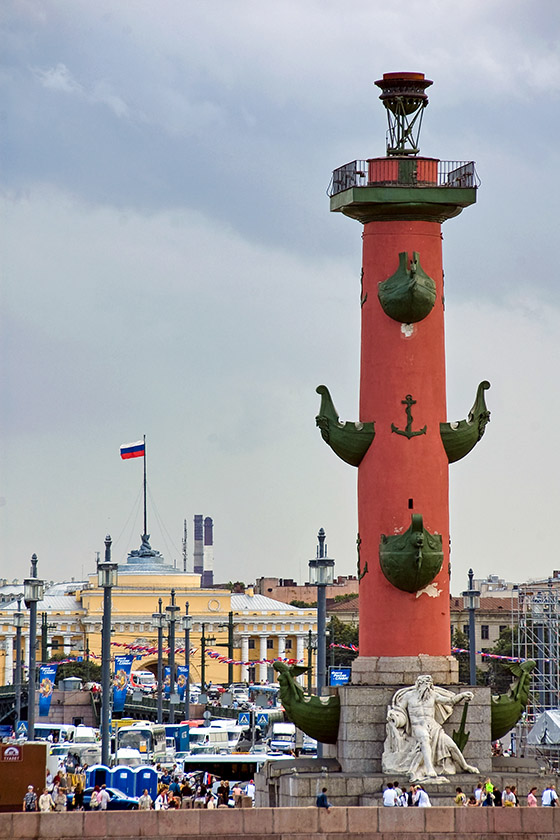
|
The pulpit |
Rostral column |
[July 29, 2007] In the morning of our second day in Saint Petersburg, the tour bus took us to Catherine Palace [67] in Pushkin. The 325 meter (1,083 ft) long Rococo building was built by Bartolomeo Rastrelli and completed in 1756. The combination of blue, white, and gold is remarkably beautiful [68]. Inside the palace, visitors are required to wear paper slippers over their shoes to protect the delicate floors. This does look a bit incongruous, especially in some of the fancier golden rooms [69]. Following the extensive damage the building suffered inside and out during World War II, massive restoration work was undertaken by the (then) Soviet government. By all accounts, the Russian craftsmen did an superb job; experts agree that today, every detail is just as it was when Catherine's summer palace was new [70]. In addition to a seemingly endless row of golden rooms, the palace contains the famous Amber Room (no photography allowed) as well as a large number of beautifully appointed 'normal' rooms [71].
But not only is the inside magnificent: the grounds are wonderful as well. We did get the opportunity to walk around a bit; first, we took a look at the Upper Bath, a 1779 building that served as a bathhouse to the royal family [72]. We strolled past the wonderful Cameron Gallery [73] to the so-called Grotto, a domed pavilion by the Great Pond. The Grotto was built by Rastrelli and completed in 1761 [74]. Four Russian men were singing inside the Grotto while we were there; their voices reverberated beautifully in the domed hall [75]. You can listen in by using the audio control under the quartet's photo; for a short (and unfortunately very poor quality) video clip of the performance, click here.
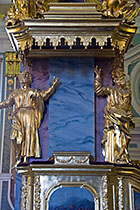 |
Catherine palace in Pushkin |
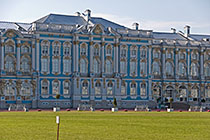
|
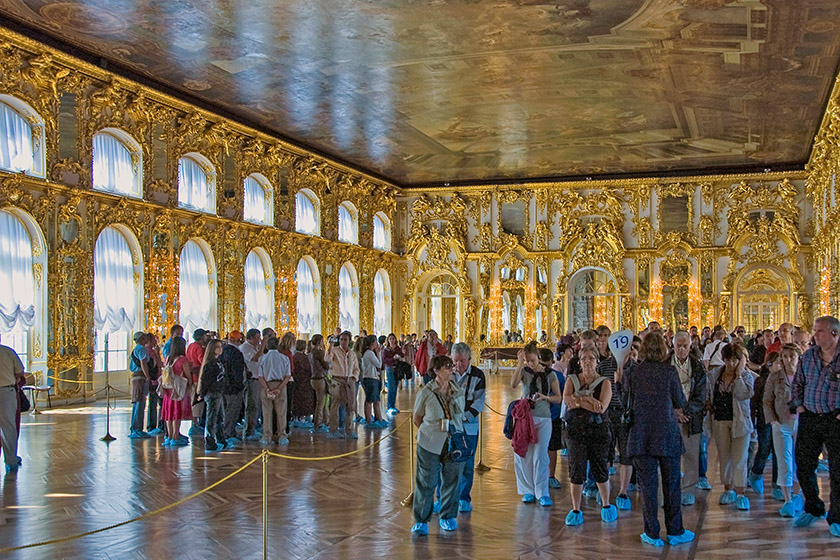
|
The main entrance |
One of the gold rooms |
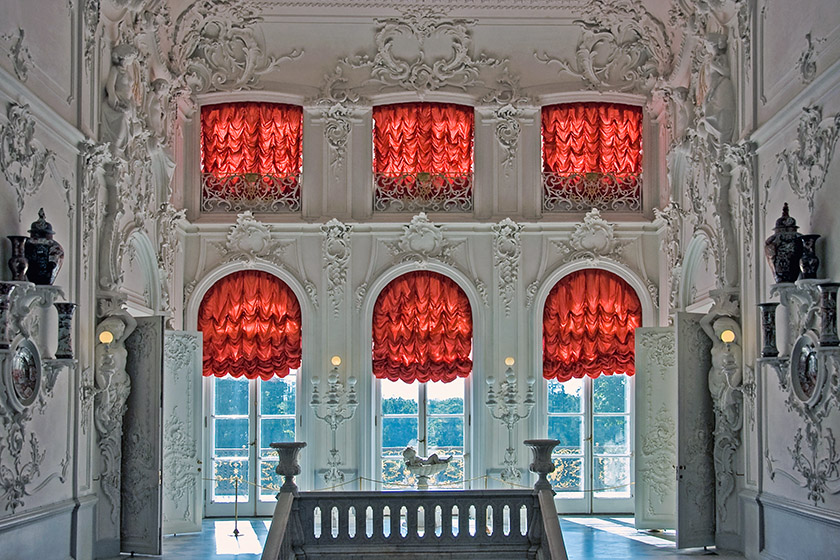
|
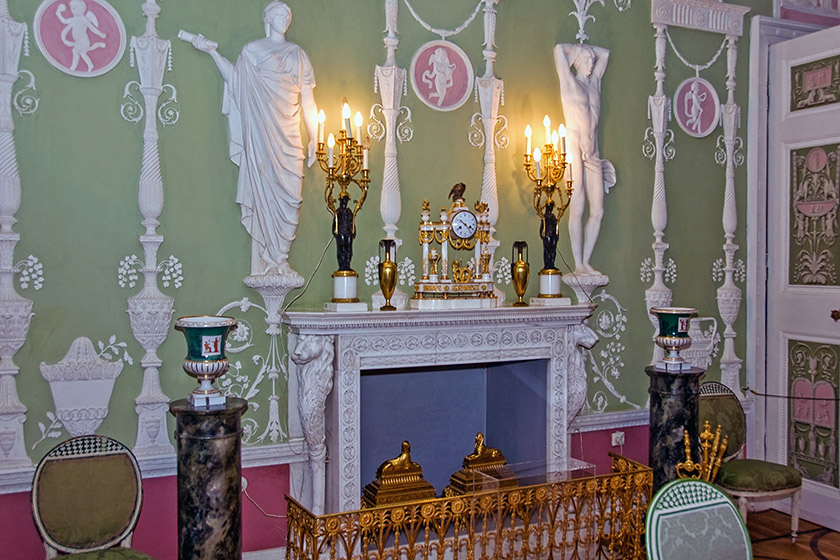
|
Stairwell |
One of the more modest rooms |
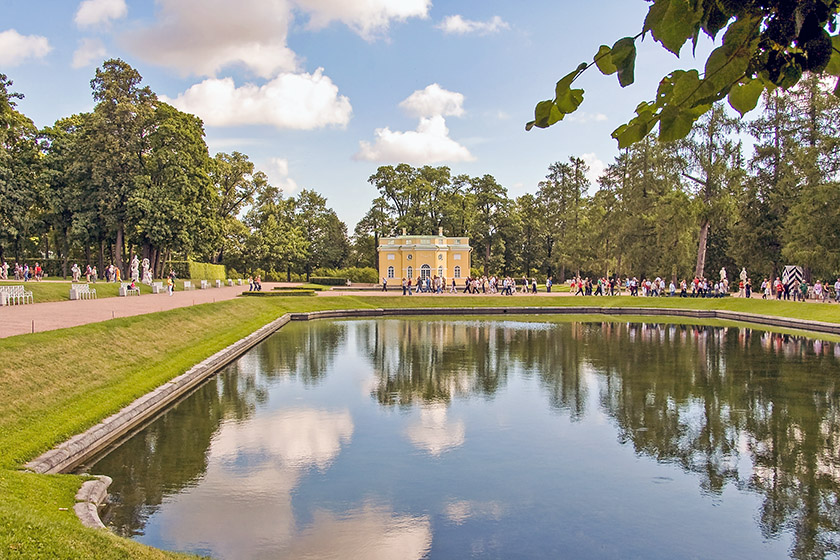
|
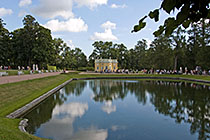
|
The upper bath house |
The Cameron Gallery |
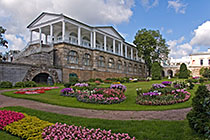
|
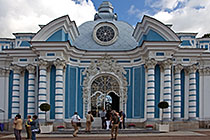
|
The grotto |
Russian quartet |
| |
In the afternoon, we visited the Hermitage [76], also known as the Winter Palace. The building itself is spectacular, and the interior is extremely well maintained [77]. The collection itself is overwhelming, and it isn't possible to see more than a fraction of the artwork on display in the countless exhibit rooms [78], especially since one is frequently drawn to the windows to admire the view, for example of Palace Square [79], Saint Petersburg's main square. The curved building is the General Staff of the former Imperial Army; through the huge central arch, one can reach Nevsky Prospekt [55].The trucks on the right are there to remove equipment used during a Rolling Stones concert that had taken place right there the night before. By the end of the afternoon, we were tired enough not to mind heading back to our ship.
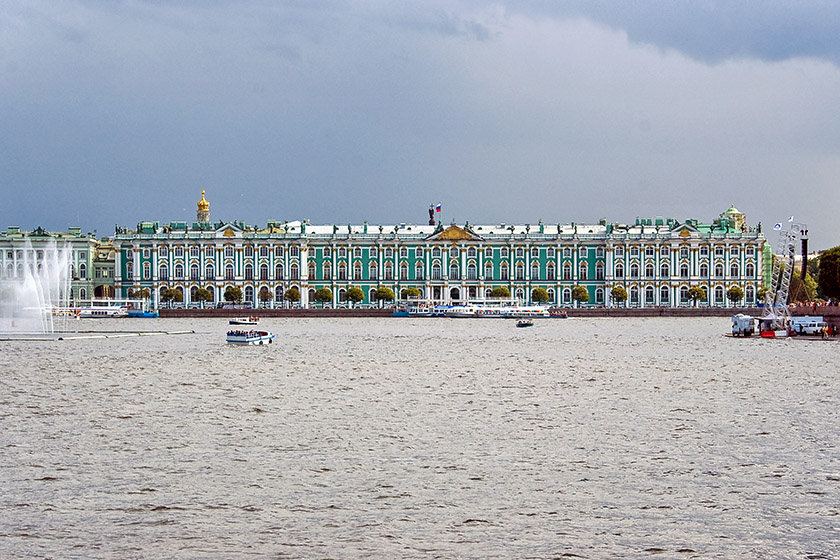
|
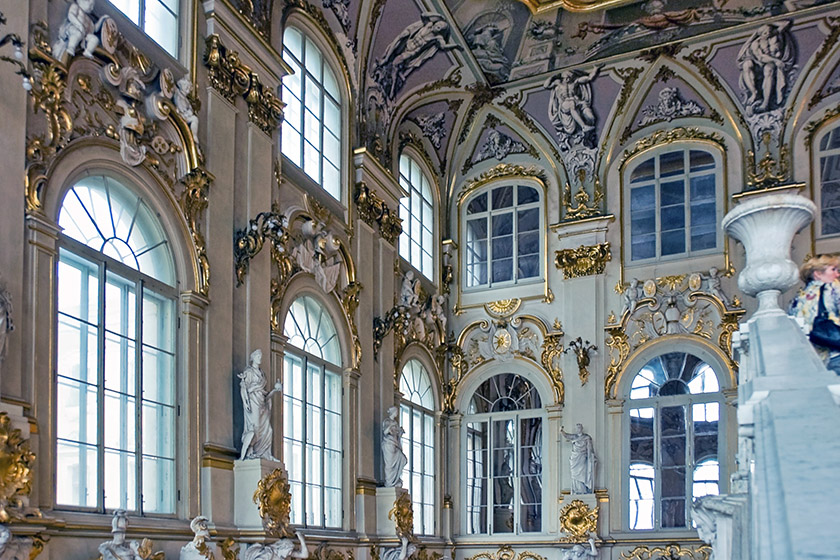
|
The Winter Palace (Hermitage) |
Inside the Hermitage |
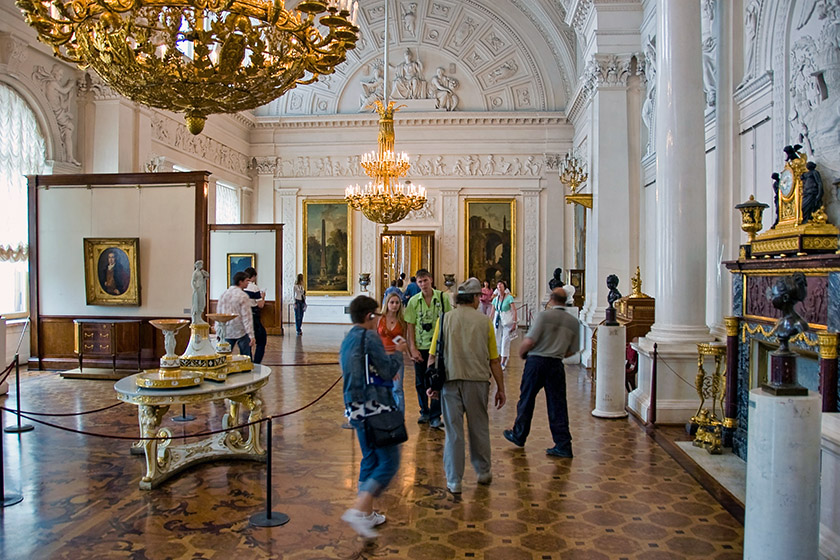
|
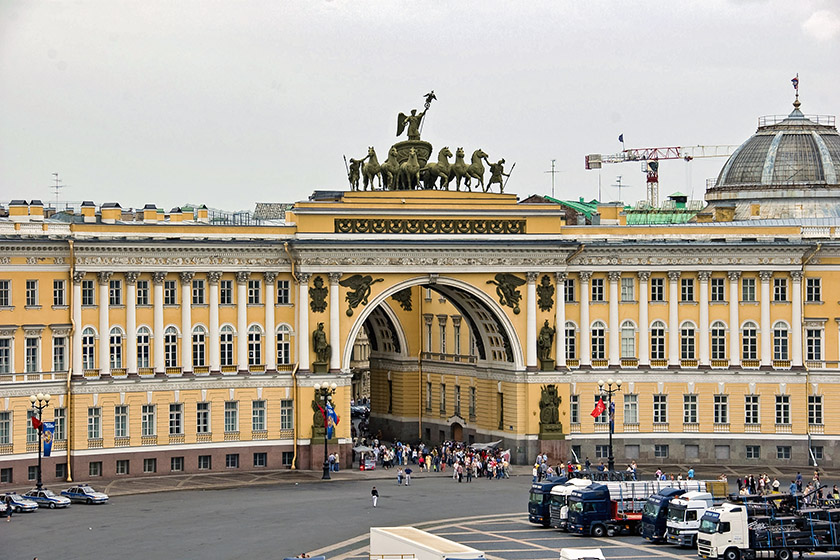
|
One of the exhibit rooms |
Palace Square |
That evening, as we left Saint Petersburg, we sailed past Kronshtadt on the island of Kotlin. Founded by Peter the Great, Kronstadt was traditionally the seat of the Russian admiralty and the base of the Russian Baltic Fleet, guarding the approaches to Saint Petersburg. Today, most installations appear to be in a shocking state of disrepair; partially dismantled warships are quietly rusting away along the piers. While we won't include any images on this page, there are a few, all taken from the deck of the Costa Atlantica, posted in this Web Gallery.
[July 30, 2007] We arrived in Tallinn, the capital of Estonia, around 7:30 the next morning. The city is divided into three parts: the upper town and lower town make up the old (medieval) Tallinn [80], and there is a new Tallinn with modern buildings, businesses, and so on [81]. Our shore excursion that morning first took us to the upper town where we visited the Nevsky Orthodox Cathedral [82]. It was built between 1894 and 1900 when Estonia was part of the Russian Empire, and to this day many Estonians resent the fact that the cathedral is the most visible structure in the upper town since it is a constant reminder of Russian domination. From the upper town, one has a lovely view of the lower town streets and rooftops, as well as St. Olaf's Church [83]. Between 1549 and 1625, when its steeple was struck by lightning and burned down, St. Olaf's church was the tallest man-made structure in the world. There are many magnificent buildings in the upper town [84], and several terraces from where to observe the lower town [85]. This is also where one of the ship's photographers caught us.The lower town features many scenic areas, such as the main square [86]. It pays to venture off the beaten path and explore the labyrinth of streets; one encounters places where time seems to stand still [87]. The lower town of Tallinn also sports some extremely environment-friendly cabs, not to mention exceptionally cute cabbies [88]. Our visit to Tallinn ended all too soon.
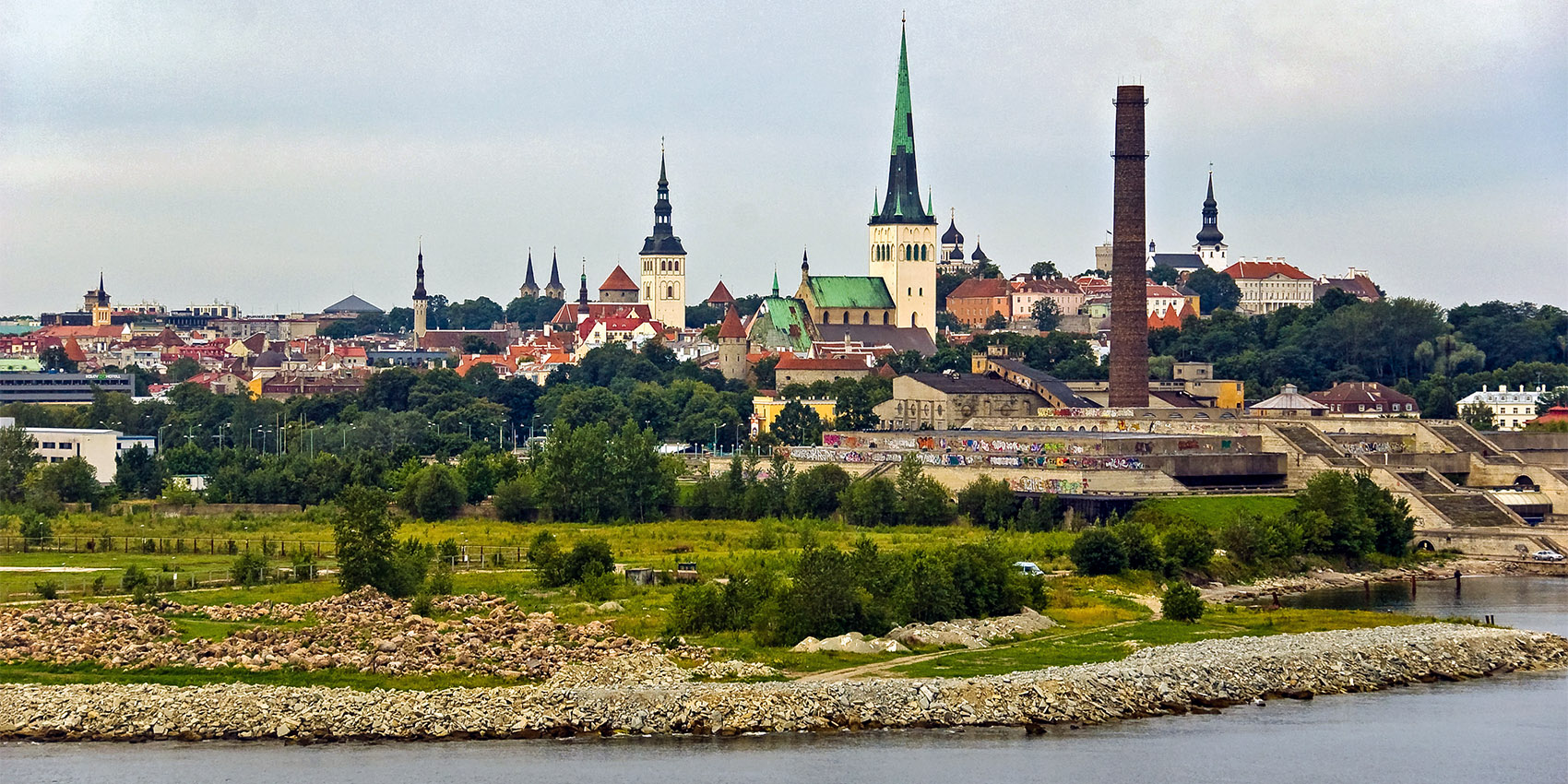 |
The old Tallin... |
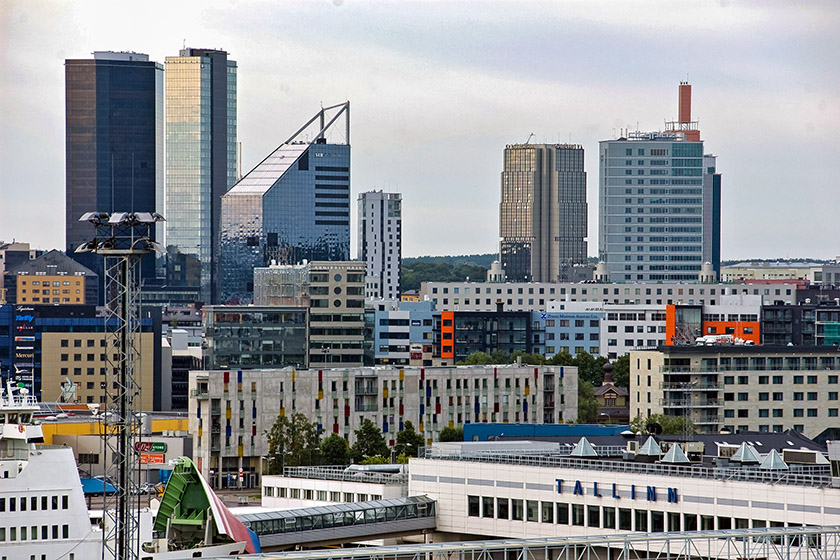
|
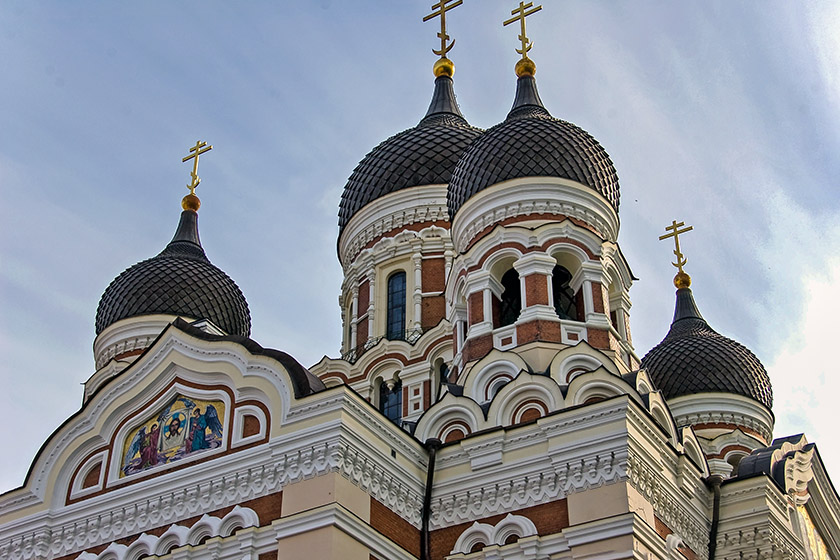
|
...and the new part of town. |
Alexander Nevsky Cathedral |
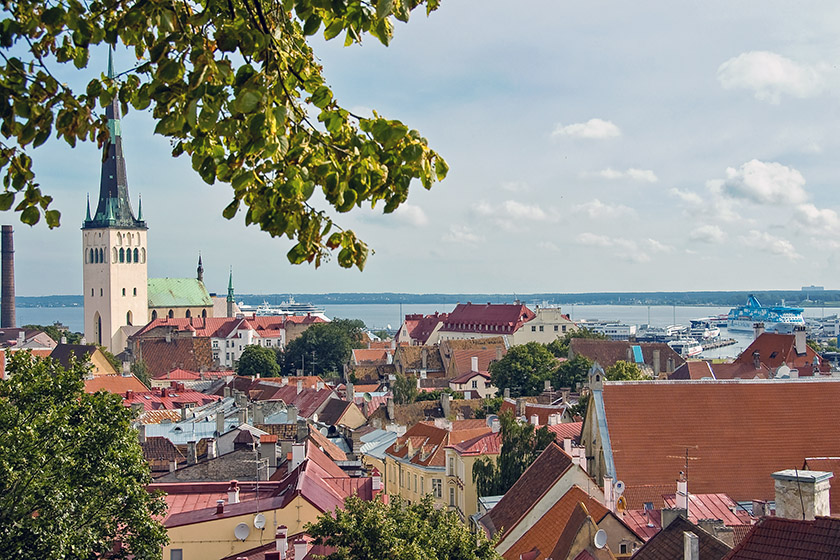
|
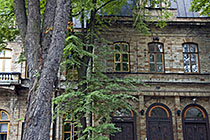
|
View onto the lower town |
Building in the upper town |
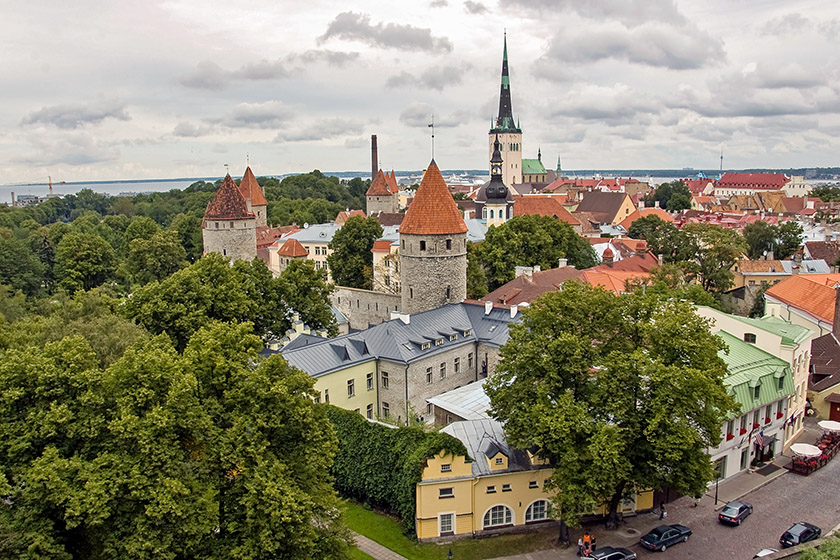
|
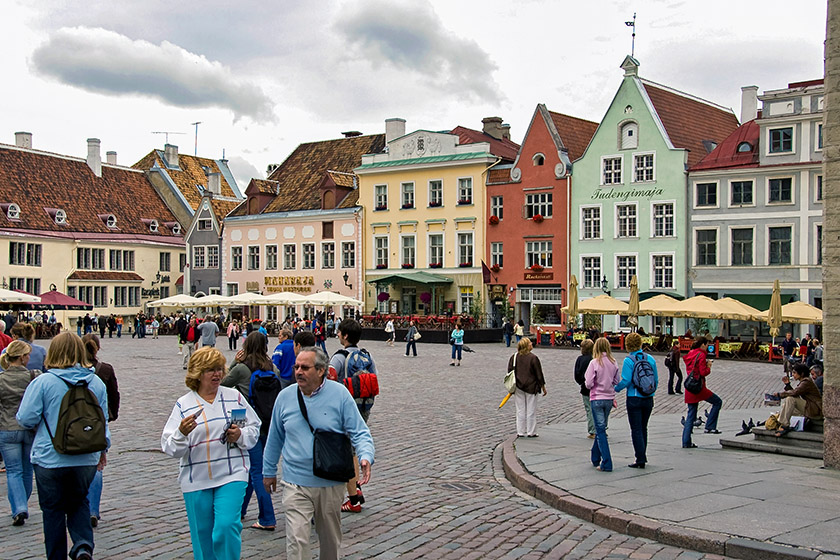
|
Another view of the lower town |
The main square in the old town |
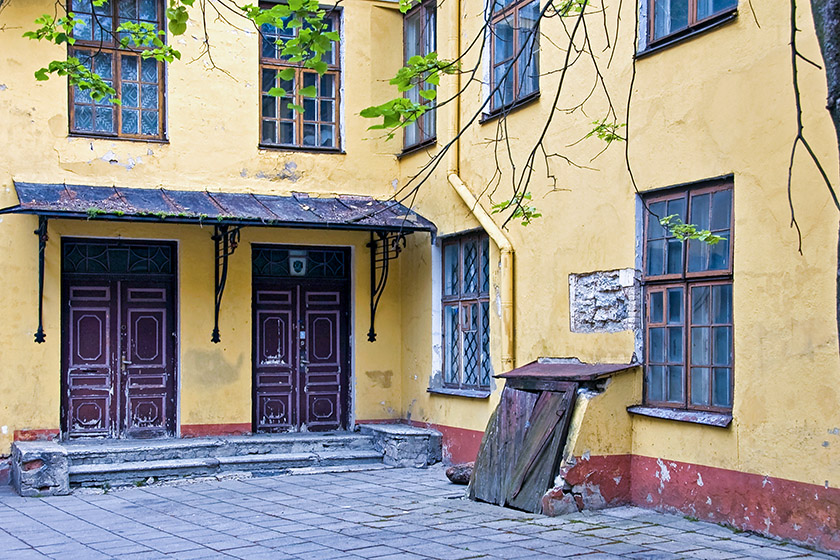
|
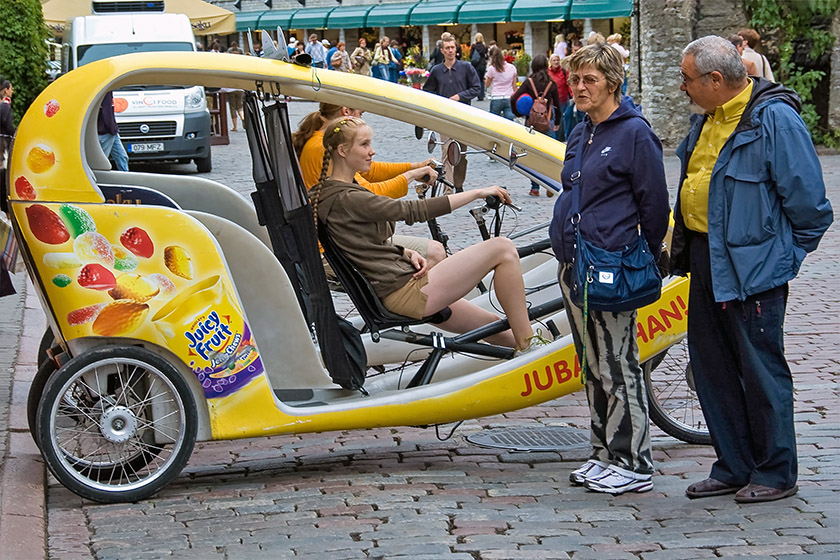
|
Courtyard |
Eye contact |
[July 31 - August 1, 2007] On July 31, we were supposed to visit the island of Bornholm, which belongs to Denmark. Because there is no pier long enough to accommodate the Costa Atlantica, passengers are usually shuttled ashore and back by means of tenders. As we approached the island, the wind was blowing at 64 kilometers per hour (roughly 40 mph) and the waves were between 4 and 5 meters (13 to 17 ft) tall. While this is all but imperceptible on a large cruise ship, it would undoubtedly get very bouncy on a tender. For this reason, the captain decided to skip the visit to Bornholm. Our guess is that he was less concerned about having one or more of his tenders sink to the bottom of the Baltic Sea as he was anxious to avoid a massive outbreak of sea-sickness. During the first of August, which was spent at sea as scheduled, the weather improved dramatically, and it was gorgeous by the time we arrived in Amsterdam on August 2.
[August 2 - August 4, 2007] Back in Amsterdam! We had a first view of this wonderful city from the upper deck of our ship as we arrived in the harbor [89]. As soon as the Costa bus had deposited us at our hotel, we consulted the map provided by the reception desk and headed towards the van Gogh museum. Again, we were struck by the number of bicycles: those driving along on the half of the sidewalk reserved for them (a true hazard for pedestrians not used to this sort of thing), and those who were chained to some bannister, awaiting their owners' return [90]. We walked past the back of the Rijksmuseum [91] and across the gigantic square to the van Gogh museum [92]. Looking back, we could see the façade of the Rijksmuseum with the huge 'I amsterdam' sculpture [93], and ahead and slightly to our left, the Concertgebouw concert hall [94]. After a visit to the van Gogh museum, we made our way back along canals [95] to the Anne Frank House [96]. The visit was difficult but well worth it; definitely recommended to anyone visiting Amsterdam. The next day, we did, of course, take a typical touristy canal cruise like this one [97]; it only takes about an hour, and one gets to see many interesting places. We spent the rest of the day just walking around, whenever possible near the water [98], something that is not exactly difficult in Amsterdam [99]! We tried to make up for all the food consumed during our cruise by eating a very simple lunch: Hot Dogs at the New Market [100].
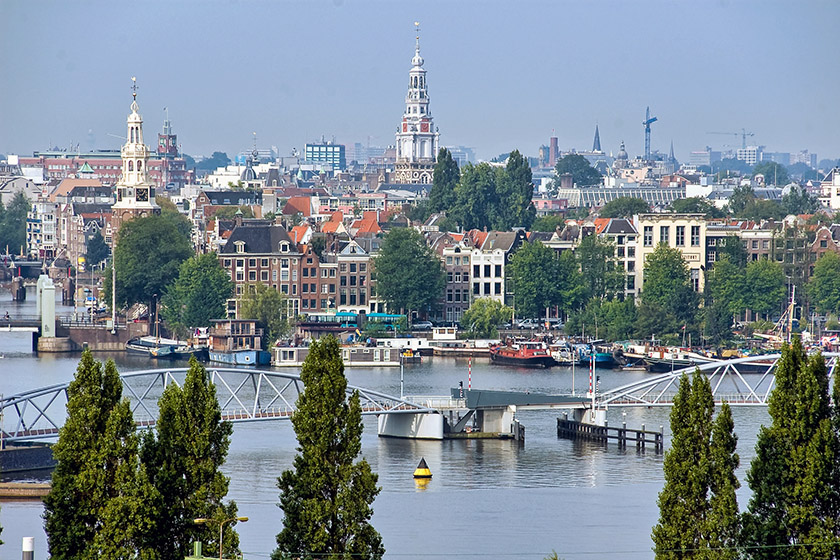
|
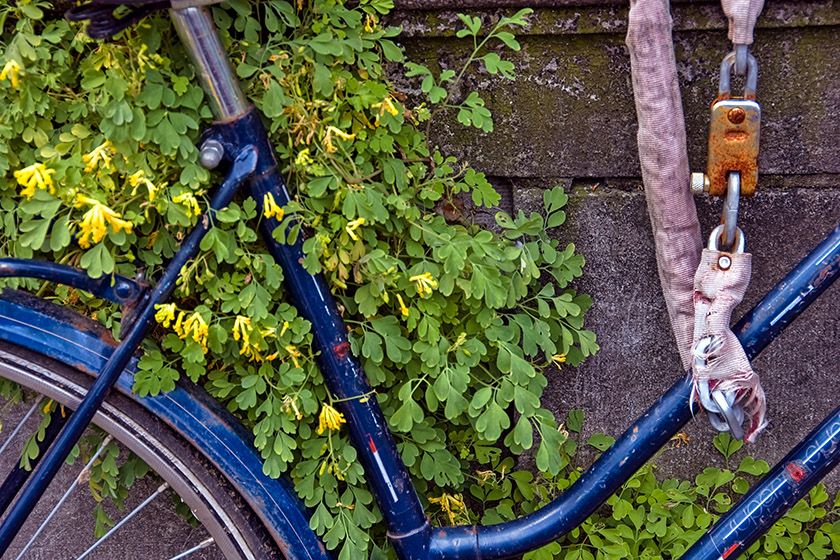
|
View from the ship to the city |
Still life with bicycle |
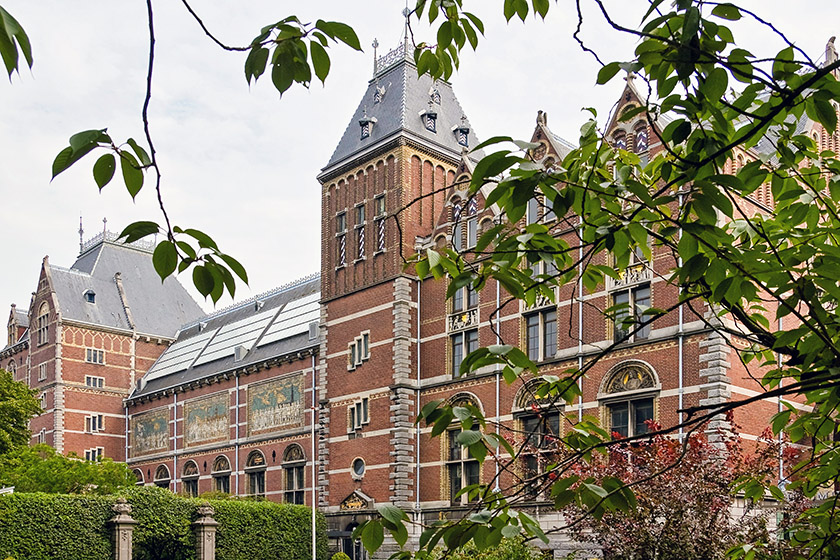
|
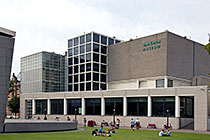
|
The back of the Rijksmuseum |
The van Gogh museum |
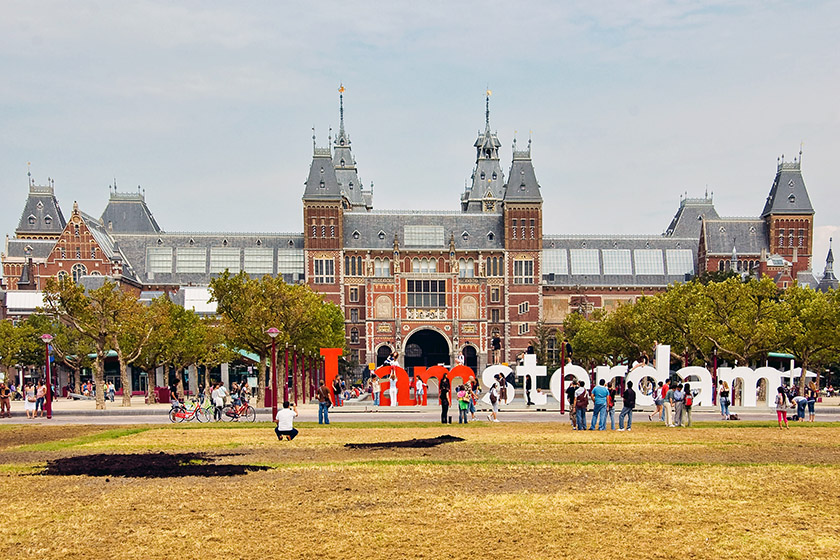
|
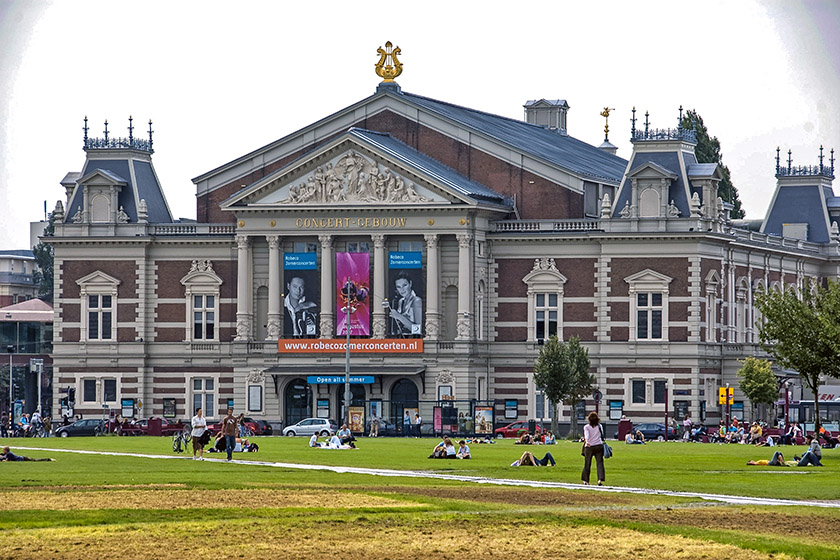
|
I AMsterdam! |
The famous Concertgebouw |
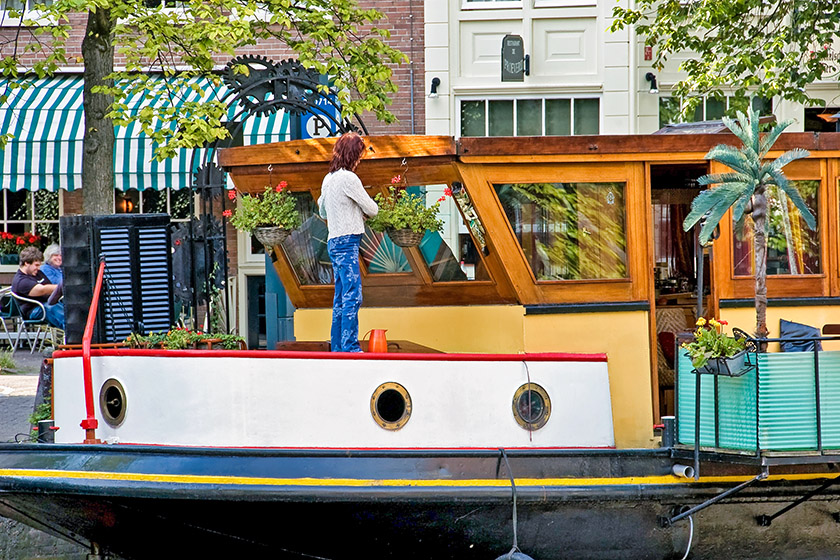
|
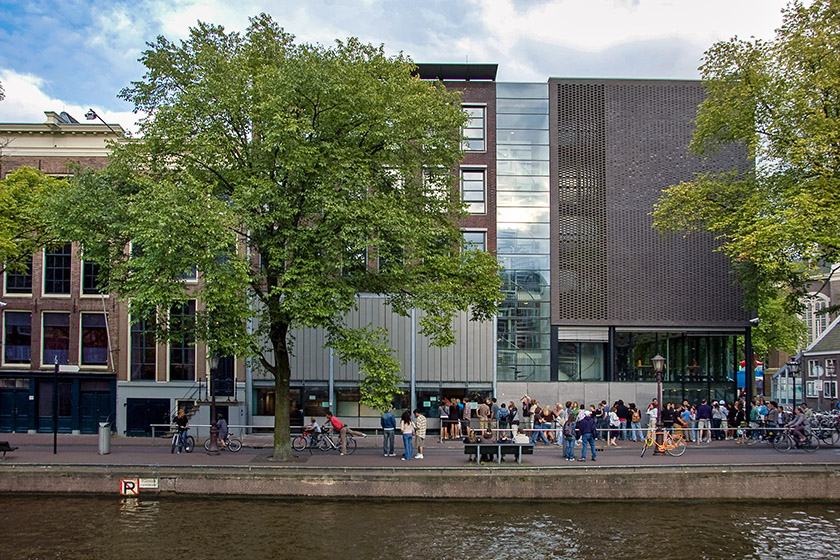
|
House boat |
The Anne Frank House |
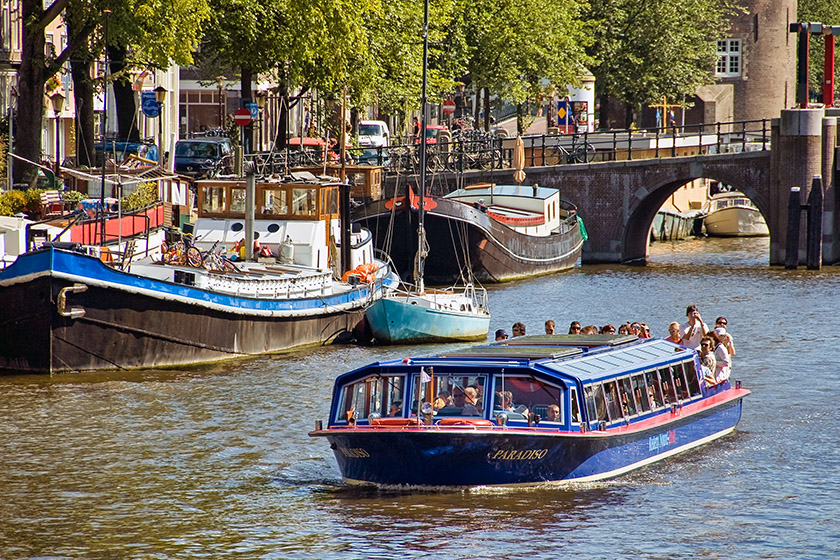
|
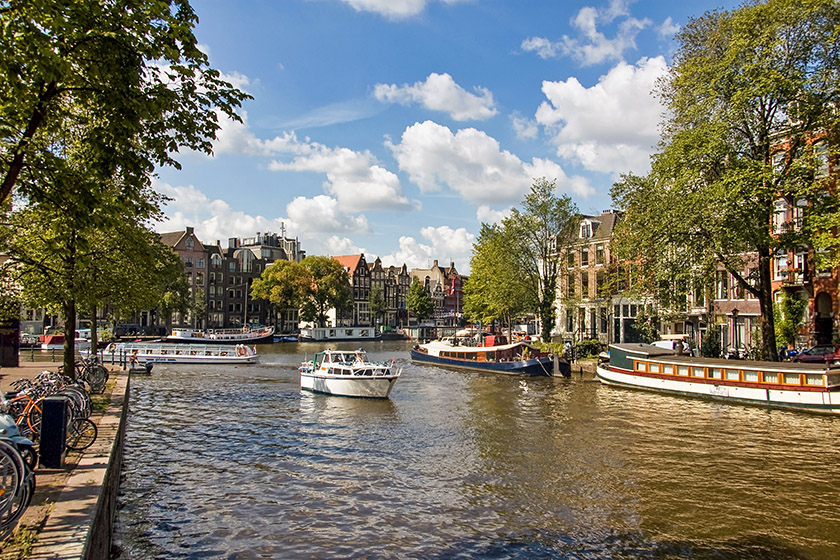
|
A great way to see the city! |
Canal scene |
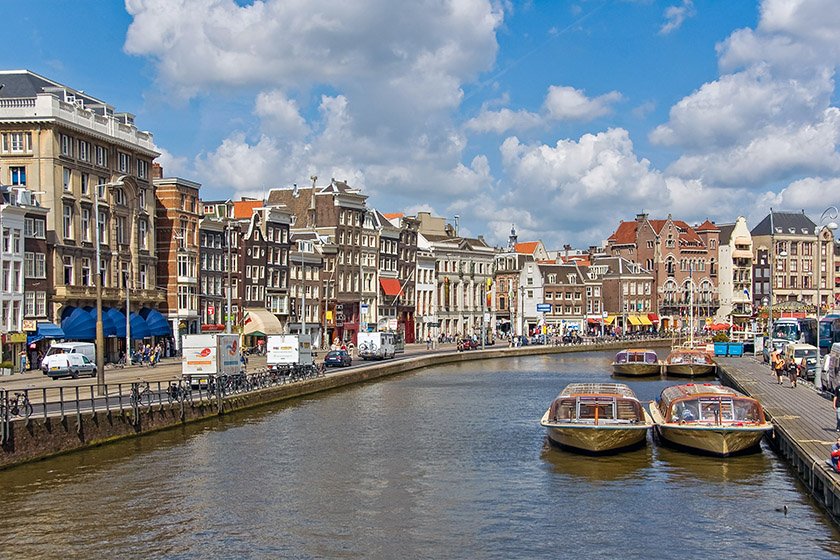
|
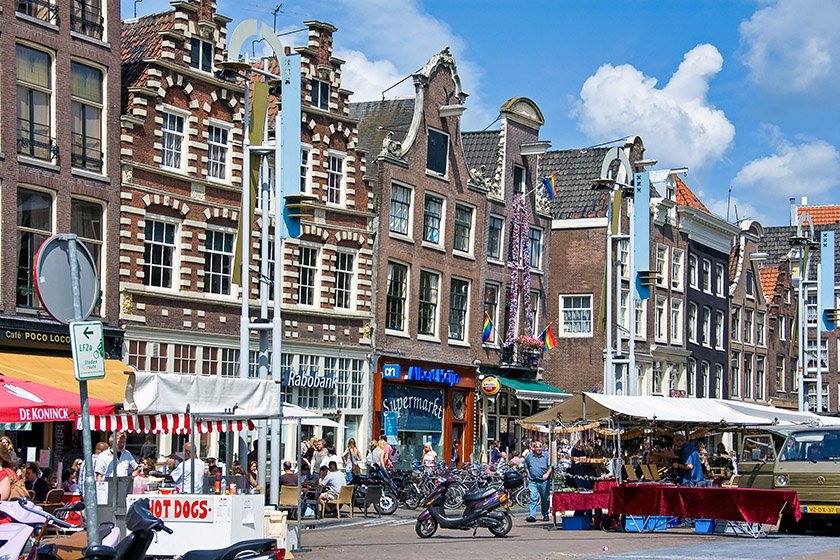
|
The Amstel |
By the Nieuwmarkt |
For our final day in Amsterdam, the sky turned true blue, yielding some postcard-like scenes [101]. We left our luggage at our hotel [102] and went exploring again. We followed a very quiet canal where low hanging branches did a beautiful job filtering the summer sunlight [103. At some point, we we came across this fancy looking building [104] that that turned out to be... a shopping mall! [105]! We passed the statue of Anne Frank by the Westerkerk [106] and followed the road to the Prinsengracht with its many beautifully maintained houses [107]. It is hard to remember where exactly we went that day, but we did end up near the center at some point [108]. That day, the 2007 Gay Pride Festival took place; literally hundreds of boats were sailing along the canals to celebrate the event [109]. We did miss most of the festivities as we had to make our way back to the hotel along the crowded Damrak [110] to catch our airport bus.
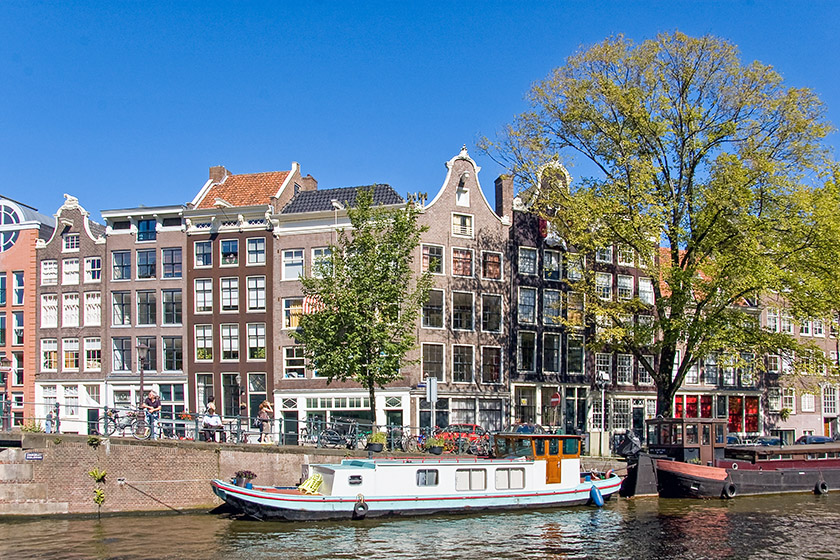
|
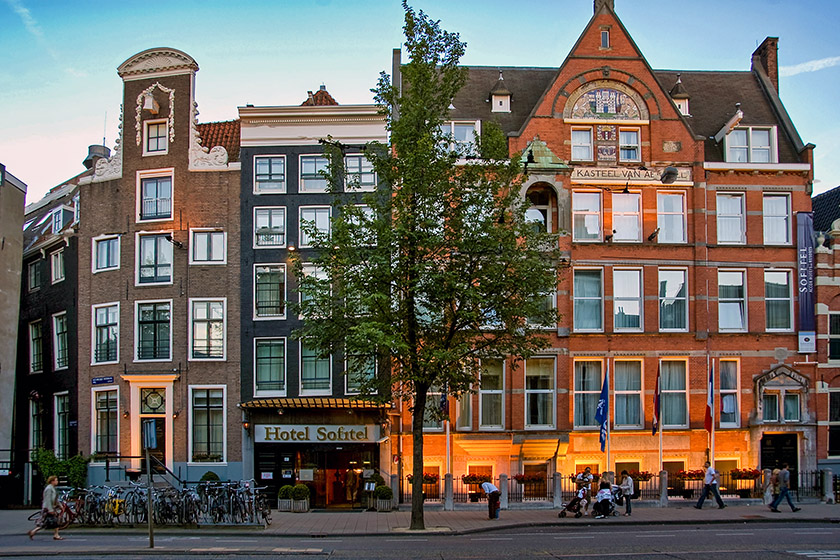
|
Picture postcard Amsterdam |
Our hotel in the heart of town |
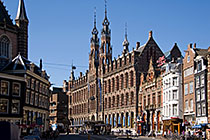
|
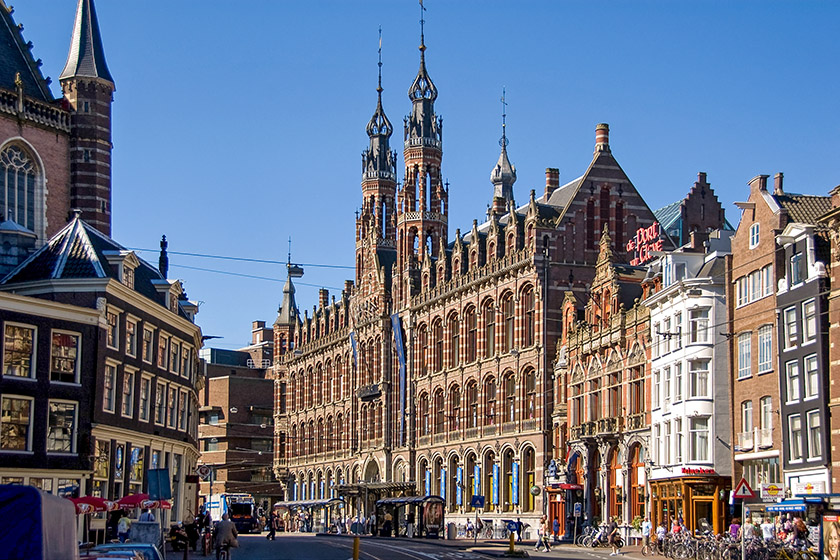
|
A lovely walk |
And this building is.. |
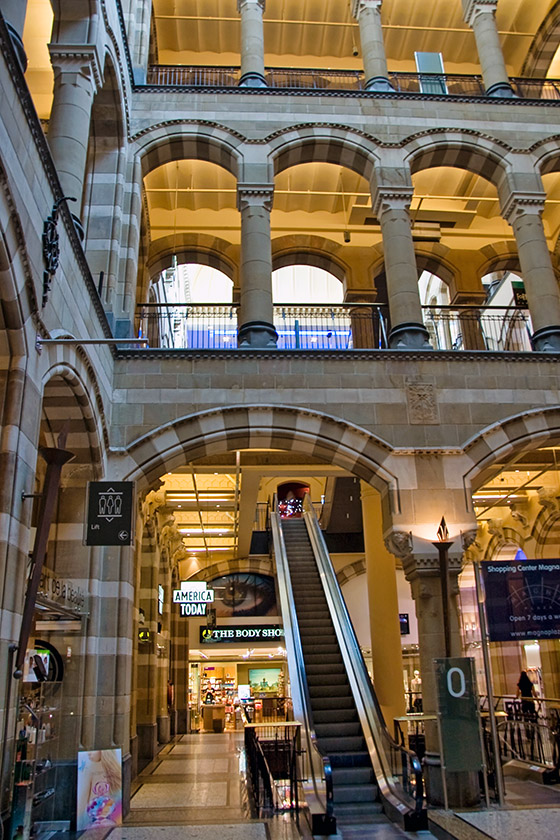
|
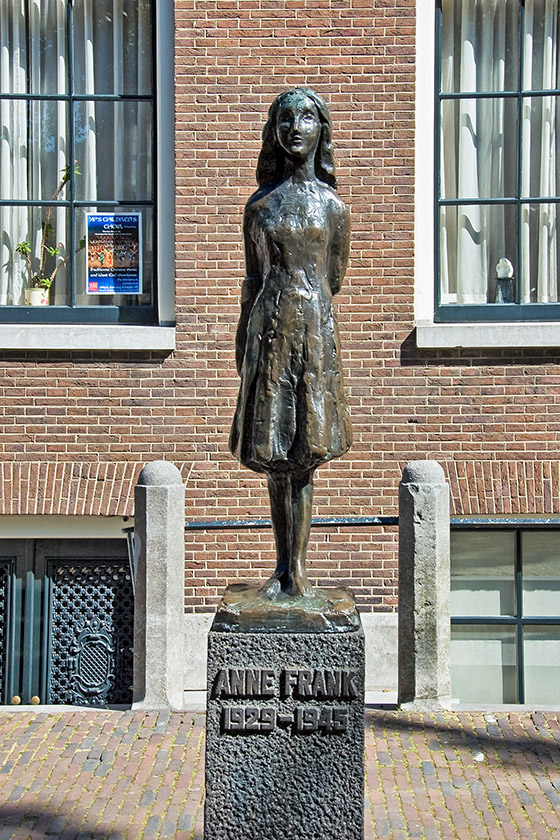
|
...a shopping mall! |
Anne Frank |
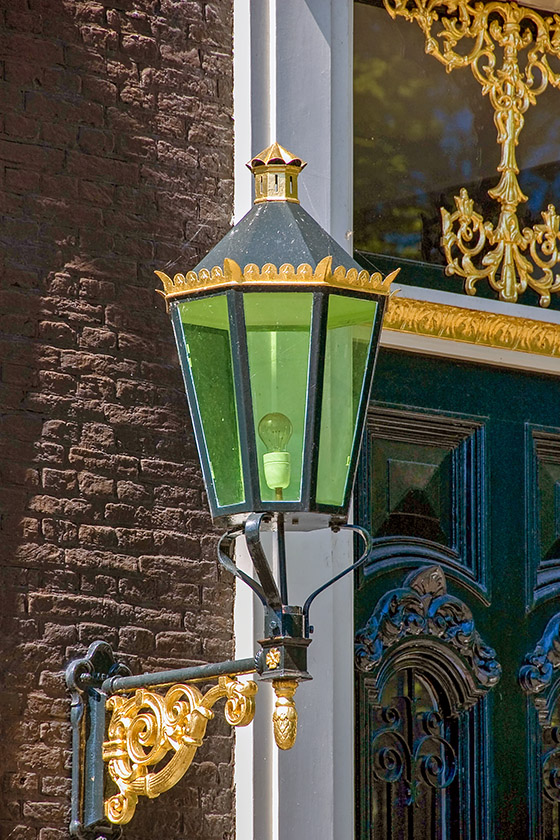
|
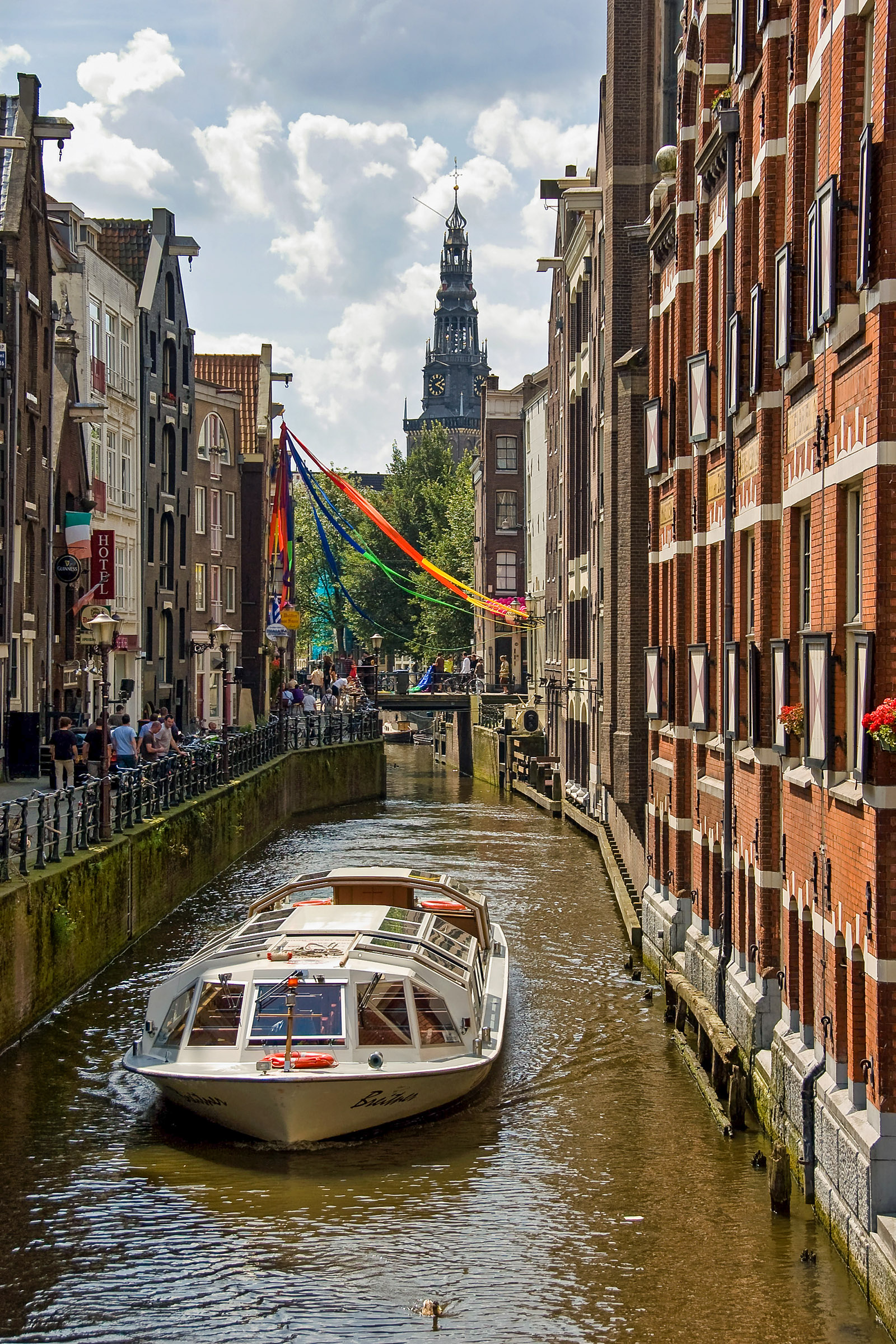
|
Detail on Prinsengracht |
Sightseeing boat |
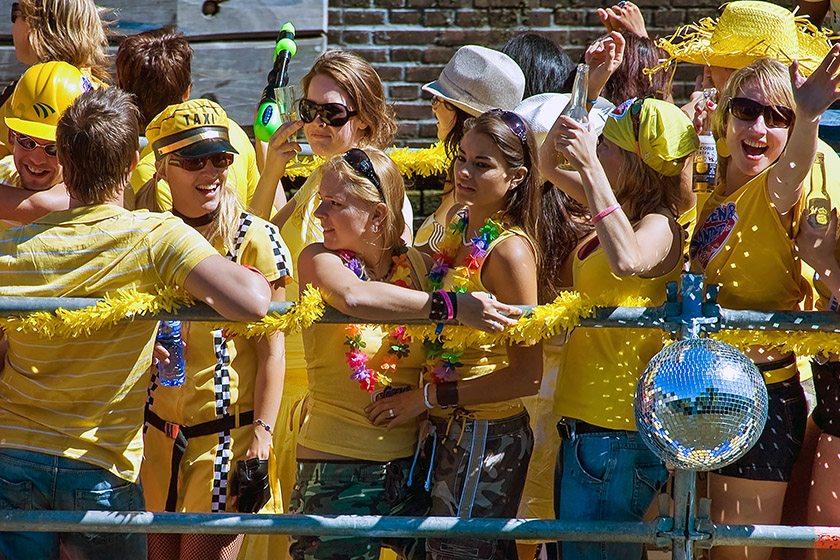
|
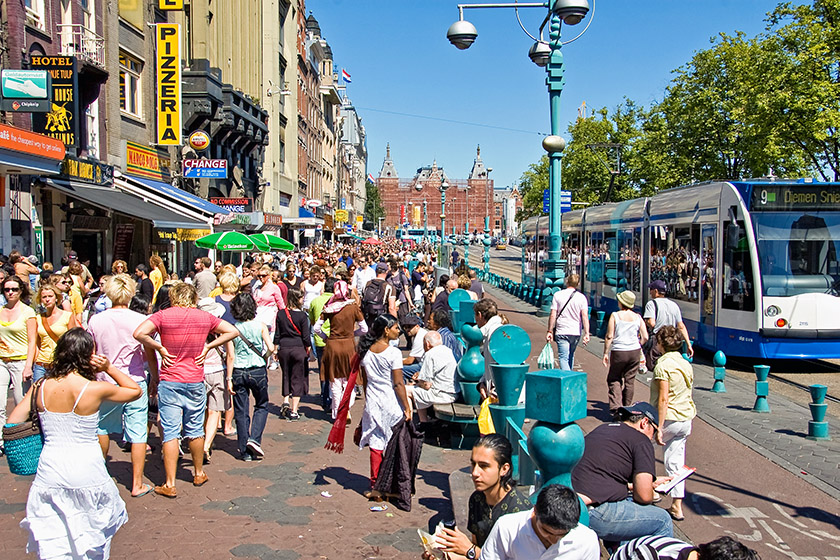
|
Gay Pride Parade participants |
Lots of people on Damrak |
This trip was an incredible experience and a wonderful way to celebrate our 30th anniversary. We visited many places we had never been to before (but would like to return to soon), and saw many things in a very short period of time. We are more than ever convinced that a cruise is the perfect way to spend a vacation, and we are already looking at cruise catalogs for ideas on where to go next. So was this, as we had said, the trip of a lifetime? Sure, absolutely. Until the next one, that is!
The first part of this trip report is on Page 1
Home | Site Info | Family | The Area | Trips | France | Work | Rants | Photography | Odds & Ends
This page was first published on August 26, 2007
This page was last modified on December 1, 2024
Send feedback about this page to feedback@kiechle.com
https://www.kiechle.com/trips/cru07b/index.htm
(optimized for Retina display)
All contents © 1999-2025 The Kiechles